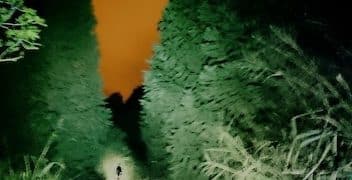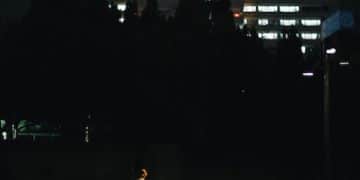Dark Ecology: US Subcultures Confronting Climate Change Through Art

The ‘Dark Ecology’ Movement explores how US subcultures are creatively addressing climate change through art, activism, and reimagining our relationship with nature, fostering a deeper understanding of ecological interconnectedness.
In the face of escalating climate concerns, a unique movement is emerging within US subcultures. The ‘Dark Ecology’ Movement: How US Subcultures are Confronting Climate Change Through Art and Activism serves as a lens to examine this phenomenon.
Understanding Dark Ecology: A New Perspective on Environmentalism
Dark Ecology proposes a radical rethinking of our relationship with nature, starkly different than the more utopian visions that often accompany environmental discourse. It is not about offering simple solutions or fostering naive optimism, but rather, it necessitates grappling with the harsh realities of ecological devastation and the complex entanglements of human and non-human existence.
This framework isn’t solely academic; it profoundly resonates within various subcultures in the US, which are actively channeling its tenets through artistic expression and grassroots activism. By emphasizing the inherent darkness and complexity of our ecological predicament, these communities aim to provoke deeper reflection and more meaningful action.

Key Principles of Dark Ecology
Dark Ecology, influenced by thinkers like Timothy Morton, challenges conventional environmental narratives.
- Interconnectedness: It underscores the inextricable link between all living and non-living entities, blurring the boundaries between human and nature.
- Acceptance of Decay: It acknowledges the presence of decay, disaster, and non-harmonious elements within ecological systems, rejecting romanticized notions of pristine nature.
- Critique of Anthropocentrism: It challenges the human-centered worldview, advocating for a more humble and less dominant positioning of humanity within the biosphere.
- Emphasis on Coexistence: It proposes that humans must learn to coexist within damaged ecosystems, rather than striving for restoration to an idealized past state.
Unlike some environmental movements that focus on technological fixes or nostalgic returns to a “natural” state, Dark Ecology urges an acceptance of the present reality and a recognition that humanity is deeply entangled with the ecological crisis.
Artistic Expressions in the Dark Ecology Movement
The principles of Dark Ecology are finding fertile ground in various artistic mediums, particularly within US subcultures. Artists are using their creativity to translate complex ecological concepts into tangible and emotionally resonant experiences. This artistic exploration serves not only as a form of environmental commentary but also as a catalyst for social action.
This art embraces the unconventional, often utilizing discarded materials, found objects, and urban landscapes to convey messages about environmental degradation and the need for a more profound connection with the natural world. Performances in abandoned industrial sites, installations incorporating recycled waste, and digital art exploring themes of collapse and regeneration are all manifestations of this artistic current.
Examples of Art in the Movement
- Land Art Interventions: Artists are creating temporary installations in blighted landscapes, drawing attention to environmental damage and suggesting possibilities for ecological restoration.
- Upcycled Art: Discarded materials and waste are transformed into sculptures, installations, and wearable art, challenging consumer culture and promoting resourcefulness.
- Digital Art and Media: Digital platforms are used to create interactive experiences that explore ecological themes, raise awareness, and facilitate dialogue on climate change.
- Performance Art: Performance artists stage interventions in public spaces, enacting rituals and symbolic actions that convey messages about environmental justice and ecological interconnectedness.
These examples offer a glimpse into the diverse and innovative ways in which art serves as a tool for engaging with the complex challenges of the ecological crisis, fostering critical thinking, and inspiring action within US subcultures.
Subcultures Embracing Dark Ecology
Within the diverse tapestry of US subcultures, a particular affinity for Dark Ecology has emerged in communities that are intimately familiar with marginalization, resilience, and creative adaptation. These subcultures, often operating outside mainstream narratives, are uniquely positioned to engage with the core tenets of Dark Ecology and translate them into tangible actions.
Punk, goth, and industrial subcultures, with their shared aesthetics of decay and rebellion, have found resonance with the themes of environmental degradation and societal collapse that are central to Dark Ecology. By integrating ecological concerns into their artistic expressions and activist endeavors, they are repurposing their cultural identities to address pressing environmental challenges.
Specific Subcultures and their Approaches
- Punk Subculture: Embracing DIY ethics and anti-establishment sentiments, punk subculture uses reclaimed materials in art, music, and fashion to protest consumerism and promote ecological awareness.
- Goth Subculture: Drawing on themes of mortality and decay, goth subculture engages with Dark Ecology through art, literature, and music, exploring humanity’s relationship with death and the impermanence of natural systems.
- Industrial Subculture: Confronting the legacy of industrialization and its environmental impact, industrial subculture uses sound art, performance, and installations to critique technological dominance and celebrate the beauty found in abandoned machinery and urban decay.
- Burning Man Community: The Burning Man festival fosters radical self-reliance, decommodification, and ecological consciousness, creating a temporary autonomous zone where participants experiment with sustainable living, collaborative art, and community building in a harsh desert environment.
These subcultures offer diverse pathways for engaging with Dark Ecology, blending artistic expression with social activism and challenging conventional notions of environmentalism.

Activism and Community Engagement
The Dark Ecology movement extends beyond artistic expression into practical activism. Numerous subcultures have taken up the cause, initiating projects rooted in community engagement and direct action to address environmental issues in their local environments. These initiatives often operate outside traditional environmental organizations, emphasizing grassroots participation and community empowerment.
From urban gardening projects in marginalized communities to organized clean-up efforts in polluted areas, these activists are translating the principles of Dark Ecology into tangible improvements and forging local networks to address environmental degradation. By fostering a sense of collective responsibility and embracing a DIY ethos, they are challenging conventional models of environmental activism.
Examples of Activist Initiatives
Here are some activist initiatives that serve to engage the community:
- Community Gardens: Transforming vacant lots into productive green spaces, community members cultivate food, promote biodiversity, and build community resilience.
- Urban Clean-up Campaigns: Organized groups collect trash and debris from polluted areas, restoring local ecosystems and raising awareness about waste management.
- Educational Workshops: Facilitating discussions and skill-sharing sessions, activists educate community members about environmental issues and sustainable practices.
- Direct Action Protests: Organized demonstrations and civil disobedience target corporations and government policies that contribute to environmental degradation.
These initiatives offer concrete examples of how subcultures are mobilizing to address environmental challenges, demonstrating the power of community engagement and DIY activism in the broader Dark Ecology movement.
Challenges and Criticisms
While the Dark Ecology movement presents a compelling framework for engaging with the ecological crisis, it is not without its challenges and criticisms. Some critiques question its perceived pessimism, arguing that it lacks a positive vision for the future and can be overly focused on the acceptance of decay. Others suggest that its emphasis on interconnectedness can sometimes overlook the power dynamics that exacerbate environmental inequalities.
Despite these challenges, the Dark Ecology movement offers an important contribution to environmental discourse by pushing for a deeper engagement with the complex and often unsettling realities of our ecological predicament. By challenging conventional narratives and fostering critical reflection, it is paving the way for more nuanced and effective strategies for addressing climate change and promoting a more sustainable future.
Addressing Common Criticisms
One of the areas of concern for the movement is the idea that it lacks actionable solutions.
- Pessimism vs. Realism: Detractors argue that its focus on decline can be demoralizing, while proponents contend that it promotes a realistic assessment of the ecological challenges.
- Overemphasis on Interconnectedness: This can obscure how issues of power and injustice exacerbate ecological problems.
- Lack of Actionable Solutions: This leaves a feeling that those involved are simply resigned to a negative future.
While these are valid discussions to be had about the movement, it is clear that the Dark Ecology movement is more about changing how we see the problem in order to create actionable solutions.
The Future of Dark Ecology in the US
The future of Dark Ecology in the US hinges on its capacity to resonate with increasingly diverse communities and adapt to the evolving challenges of the ecological crisis. As climate change continues to impact communities across the country, the insights offered by Dark Ecology are likely to become even more relevant and influential. By fostering interdisciplinary collaboration and promoting creative solutions, the movement can amplify its impact and contribute to a more sustainable and just future.
One of the key aspects of this process will inevitably entail more dialogue between activists and academics. This cross-pollination between academic and activist sectors will help to foster new ways of engaging with the Dark Ecology movement. Regardless, Dark Ecology will inevitably play a role in the future of ecological discussion in the US and beyond.
Key Takeaways
The ‘Dark Ecology’ Movement explores how US subcultures are creatively addressing climate change through art, activism, and reimagining our relationship with nature, fostering a deeper understanding of ecological interconnectedness.
| Key Point | Brief Description |
|---|---|
| 🌱Core Principles | Interconnectedness, acceptance of decay, and challenging anthropocentrism. |
| 🎨Artistic Expressions | Use of discarded materials & urban landscapes for environmental commentary. |
| 🤝Community Engagement | Grassroots activism, community gardens, and urban clean-up campaigns. |
| 💭Criticisms | Accusations of pessimism, overlooking inequities. |
FAQ
Dark Ecology is a philosophical approach that challenges conventional environmental narratives by emphasizing interconnectedness, decay acceptance, and a critique of anthropocentrism.
By translating complex ecological concepts into artistic expressions, activists seek to provoke deeper reflection and promote meaningful action. This art is used as environmental commentary.
Community gardens, urban clean-up campaigns, educational workshops, and direct action protests are all examples of activist initiatives within the ‘Dark Ecology’ Movement .
US subcultures are heavily involved because of their history in marginalized communities and pre-existing familiarity with the issues that inform the movement.
Critics suggest that the movement can be overly pessimistic and lacks a positive vision. Others warn about oversimplifying injustices or ignoring implementable solutions.
Conclusion
The ‘Dark Ecology’ Movement offers a powerful lens through which US subcultures are creatively confronting climate change through art and activism, providing valuable insights for addressing the ecological challenges and injustices of our time.





